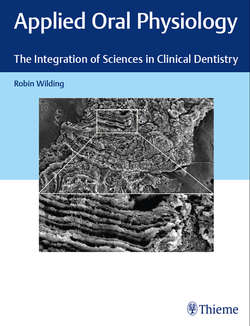Читать книгу Applied Oral Physiology - Robin Wilding - Страница 52
На сайте Литреса книга снята с продажи.
3.6.1 Functions of Cementum
Оглавление• Cementum provides a means of attachment and reattachment of periodontal fibers to the tooth root. During continued eruption and drift the periodontal fibers have to be removed and reattached into the cementum. Cementum is also a key role player in the reattachment of periodontal ligament fibers to the tooth during healing of a periodontal pocket.
• Cementum protects the underlying dentinal tubules from exposure to oral fluids and bacteria. If the epithelial attachment to the tooth root migrates apically, cementum may be exposed. It is softer than enamel and easily abraded during overzealous scaling or incorrect tooth brushing techniques. If the underlying root dentin is exposed in this way, it may become sensitive and cause discomfort which can be difficult to reduce.
• Addition of new cementum around the apex of the root compensates for tooth wear on the occlusal surface and provides a means of continued eruption of the tooth. Continued eruption may also be caused by alveolar bone growth.
Cementum forms a thin uneven layer over the root surface. It is thinnest at the cervical (toward the neck) end of the tooth and thickest at the apex. At the CEJ, cementum may either overlap the enamel (in about 60% of teeth) or meet edge to edge. It may also be deficient in meeting the enamel leaving a zone of exposed dentin which may become sensitive during tooth brushing (▶ Fig. 3.10).
Fig. 3.9 SEM images of the inner surfaces of a tooth socket (magnification × 500). (a) The apical part of the tooth socket (toward the left of the micrograph) is perforated with a number of foramina for blood vessels and one or two larger ones near the apex for the bundle of nerves and vessels entering and leaving the pulp through the apex of the root. (b) The gingival part of the tooth socket is also perforated by many large foramina through which blood vessels supply the periodontal ligament and the free gingiva.
Fig. 3.10 A diagrammatic representation of the variation in configuration of the cementoenamel junction (CEJ). In 10% of subjects, dentin at the CEJ may be unprotected by either enamel or cementum. The configuration of the CEJ may vary within individuals.
It is possible to recognize different types of cementum based on the presence or absence of cells and fibers. Afibrillar (no fibers) cementum is uncommon but may be seen overlapping the enamel for a short distance at the CEJ. Most cementum contains fibers from two sources. Intrinsic fibers are thin and sparse and laid down as part of the ground substance. Extrinsic fibers come from the periodontal ligament and are trapped in the cementum as it forms. These extrinsic fibers provide an anchor of attachment between the periodontal fibers and the root of the tooth. The cells which form cementum are not evenly distributed but are more common toward the apex of the root surface, where there is active formation of new cementum (▶ Fig. 3.11).
Cementum shows incremental lines which correspond to periods of inactivity. Mostly, there is apposition of cementum which continues throughout life; in fact, cementum thickness is a useful indication of the age of a tooth (see Chapter 11 Ageing). Cementum rarely seems to resorb under natural conditions but may do so in response to excessive forces used during orthodontic tooth movement. Sometimes, cementum accumulates in unusually thick deposits (hypercementosis), and this may make extraction of teeth difficult as the bulbous apex locks the tooth into the bony socket.
